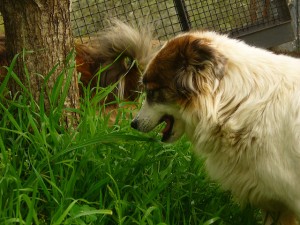Table of Contents
- 11 Interesting Dog Behavior Facts for Kids
- Resting Their Head on Paws
- Showing Their Belly
- Dog Behavior Why Dogs Raise Their Front Paw
- Dog Facts About Chase Their Tail
- Twitching While Sleeping
- Head Tilting Dog Fact
- Dog Behavior of Destroying Their Stuffed Toys
- Eating Grass
- Dogs Eating Things That Dogs Shouldn’t Eat
- Peeing on Other Dogs' Pee Behavior
- Dog Behavior of Rolling in Smelly Things
- Before You Go…
Ever wonder why your dog does certain behaviors around you?
Are you curious why dogs like to look at you sideways or why they roll around in smelly things?
You probably have never consumed yourself with these thoughts, but maybe your children have.
After all, they are still curious, and these types of exciting dog facts for kids will be fascinating to them.
However, that is not to say that these exciting dog facts for kids will not appeal to adults.
Canines are much more than our loyal companions and friends. They are fascinating creatures, and when we take a second to observe a dog's behavior actively.
There are many things to notice, including some of these exciting dog facts for kids and adults alike.
You will quickly see how many questions are being raised whenever you pay attention to your pup's behavior for a very long time.
Let’s take a very brief and quick look at some of Top Dog Tips' exciting dog facts for kids that fascinate adults.
I found a lot of curious information on why dogs do what they do, which I didn't know about while researching this post.
Here we go!
11 Interesting Dog Behavior Facts for Kids
Did you know that when dogs are…
Resting Their Head on Paws
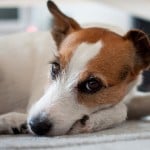
When a dog rests his head on his paws, it doesn't necessarily mean that he's sad or lonely, even though it might look like this.
This position can tell that he's bored or trying to look adorable, especially if you are eating something that your pet wants you to share with him.
They can also make that stance when trying to understand what you are saying to them.
Perhaps your puppy wants you to say his favorite words: “walk,” “treat,” or “let’s go for a car ride!”
“A dog lying down with its head on its paws will have a closed mouth, making a dog look less happy.
The eyebrows often move as the dog looks around, which can make a dog look pensive, and the dog doesn’t look that energetic, which can be confused with sad.
However, a dog lying down is likely to be pretty comfortable in the situation since dogs rarely lie down if they are scared or agitated.”
– Karen B. London, Ph.D.
Showing Their Belly
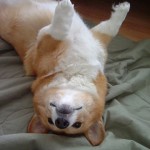
Do you know what it means when a dog rolls over and shows off his belly?
Demonstrating their belly could mean a few different things.
Your puppy could be asking for some love and attention, or he may need help scratching a hard-to-reach itch.
This could be a sign of submission, too.
RELATED: 11 vital dog care tips
If your dog looks relaxed and staring at you, it’s lovely to give them attention.
However, if your Fido's body seems tense and he's not making eye contact with you, beware!
The dog might not recognize you, your superiority, or isn't too friendly with you.
Exposing their belly to other dogs is also a sign of submission, which shows that he does not want to challenge the other dog.
Dog Behavior Why Dogs Raise Their Front Paw

When a dog raises his front paw, it can also mean multiple things.
If he grows his front foot and looks at you in that cute manner, he probably wants you to stop what you are doing and pay some attention to him.
Some dogs (and certain breeds especially, like Beagles and German Shorthaired Pointers) raise one paw to show hunters where animals or birds are.
They are trained to do this sort of thing.
“Raising front paws appears to be a sign of friendliness or appeasement in dog body lingo.
The telling sign is all about bent elbows. A play bow, single paw raise, double paw raise (yes even as when jumping up), batting with a paw, tap dancing, etc. all are meant to convey friendliness and sociability.”
– Open Paw, a non-profit pets organization.
Dogs might also raise their front paw because something is wrong with their paw.
Maybe they stepped on a sharp object, had something stuck in their toes, or even a pulled muscle.
Your dog can even lift his paw when meeting a new dog or person or finds himself in a new place and feels uncertain.
Dog Facts About Chase Their Tail
What is the big deal about dogs chasing their tails?
This is possibly one of the most popular and exciting dog facts for kids.
So why do dogs do it?
The reason your dog chases his tail is that he can!
Sometimes the answer is as simple as that.
However, there can be many other reasons as well.
RELATED: 11 essential basic dog training tips
Your puppy might be chasing his tail because of an obsessive-compulsive disorder or just temporary OCD behavior.
OCD in dogs is a thing, and many dog researchers are currently investigating this field.
Another reason your Fido is chasing his tail is that he thinks that his tail is prey and he must catch it.
Dogs can also be bored and want to have fun by amusing themselves with some tail-chasing, which is especially true for young puppies who do that often.
“For some dogs, the behavior will disappear naturally. Veterinary intervention may be required to diagnose and treat the underlying conditions properly.
As a rule of thumb, if the behavior is getting more frequent or persists longer than a week, see your vet.”
– VetWest Animal Hospital.
Twitching While Sleeping
There's a lot of effort in analyzing dog sleeping behavior and the canine brain in general.
Scientists like Alexandra Horowitz and Gregory Berns spend their entire lives figuring out what is inside a dog's head.
There are some fascinating and exciting dog facts for kids and their parents that science has brought forward.
To answer, just like us, dogs can dream.
Twitching probably represents the same thing it does in humans.
We probably say that even with people, scientists still aren't sure what that twitching is, but we know that it represents the action you think you're doing in your sleep.
For all you know, your dog could be chasing a squirrel because sometimes he looks like he's running on all fours, doesn't he?
RELATED: 21 must-know dog training tips
It would help if you were careful, though, and observed your Fido closely.
Sometimes, twitching can be a health condition called involuntary muscle trembling or tremors in dogs.
Here's what PetMD has to say about this condition:
“Tremors are involuntary, rhythmic, and repetitive muscle movements that alternate between contraction and relaxation, usually involving to-and-fro movements (twitching) of one or more body parts.
The tremors may be rapid or slow vibrations, which can occur in any part of the body.
Tremor syndrome usually affects young-to-male dogs and has been known to affect white-colored dogs primarily, but a variety of hair-coat colors are also affected.”
Head Tilting Dog Fact
Isn’t it so cute when your dog looks at you with his head titled to one side?
Very.
But why does he do this?
The reason is usually that your Fido is trying to understand what you are saying.
He might also be trying to read your face more clearly or attempt to hear your voice and commands.
There are several theories on why pets do this, but no hard-proven facts.
Maybe your pup is listening in to hear the magic words: “treats,” “walk,” “food,” and “car ride.”
Perhaps he's trying to figure out where a particular sound is coming from and what to do with it (with that command or word).
We still can't say for sure, but Stanley Coren, a famous dog psychologist and the author, has a fascinating theory on this which he came up with after conducting a survey online.
“We know that dogs continually scan our faces for information and to read our emotional state.
Hence, one reason dogs may tilt their heads when we talk to them is that they want to see our faces better and compensate for how their muzzles obscure part of their vision.” – Stanley Coren, Ph.D.
Now, who's up for some pug head-tilting session?
Dog Behavior of Destroying Their Stuffed Toys

This probably drives you crazy – buying expensive dog toys every single time so that your dog can destroy them in a matter of days.
This is even more maddening if the dog ruins your toys (if you have any) or your kids' toys!
Why are canines acting so destructive on occasion?
We can put the majority of the blame on their hunting instincts, and there's nothing we can do about it.
They're dogs, after all.
RELATED: 25 best dog toys for strong chewers
We must remember that canines were once wild animals long ago before they became our pets and loyal friends.
Dogs destroy toys because they put their hunting skills into action; it's prey to them.
Chewing toys also help keep your pup occupied when they are bored or even anxious, as it can be relaxing for them, which is why most dog owners consider dog toys to be a must-have purchase on day one.
Destroying toys also helps your canine to feel as if they accomplished something.
Note that this type of destructive behavior in dogs can sometimes grow out of proportion.
At this point, you might want a dog expert, animal behaviorist, or preferably a veterinarian to take a look at it.
Your dog can be experiencing severe cases of anxiety, which needs to be treated and cannot be left without attention.
Eating Grass
Another popular question and one of the fascinating dog facts for kids is why canines love eating grass so much.
Is it so tasty for them?
The adage is that grass helps dogs with upset stomachs or something related.
Fortunately or not, this was found to be not true and simply an old myth.
Again, there are multiple theories on why dogs might do this.
Maybe they get bored of eating the same old dog food day in and day out, and now they're looking for a bit of variety in some greens?
Probably not, but it could be the case. Sometimes, your dog likes the taste and texture of the grass and will eat a lot of it simply because it's there.
Once again, Stanley Coren has stepped in to shed a little light on why dogs eat grass using some scientific evidence:
“The researchers conclude that grass eating is common in normal dogs and is generally not associated with illness or dietary needs.
They suggest that grass eating may reflect an innate predisposition inherited from dogs' wild ancestors.” – Stanley Coren, Ph.D.
Dogs Eating Things That Dogs Shouldn’t Eat
All the grass aside, dogs are known to eat all kinds of random things that, ideally, you wouldn't want them to eat.
Essentially, your dog, especially if he's young, can eat just about anything: clothes, bags, plastic, wood, toys – you name it. Why are dogs doing that?
Sometimes, your furry friend is curious about the environment and likes to taste things around him to get to know something.
This is why “eating everything around” is most often attributed to puppies.
Other times this can be a common behavioral problem, and your dog will need to go through training so that you can stop him from obsessively eating everything in sight.
Finally, this can also be a medical disorder called Pica, which means you would need to visit your vet to see what is going on.
RELATED: How to teach a puppy to walk on a leash
ASPCA warns about this well-known disorder among many dogs and gives you a few hints on how to treat it or what to do if you encounter this problem in your four-legged pal:
“The consumption of nonfood items is a disorder called pica.
Although pica can be a sign that a dog’s diet lacks some nutrients, when pica occurs in puppies and young dogs, the most common culprit is boredom.
Occasionally, eating nonfood items develops into compulsive behavior, resulting in a dog who’s highly motivated to find and consume specific objects.”
Peeing on Other Dogs' Pee Behavior
Why in the world do dogs pee on other dogs' urine?
They do this because they are “marking.”
If your pet is doing this, he's covering the other dogs' urine smell with his own to show that he's now in charge.
Contrary to popular belief, males and females do that; however, male dogs do this more often than female dogs.
There are also many other reasons dogs might be urinating over someone else's urine. It can be a social trigger: your pal or gal is attracting another dog for interaction or mating.
It can be to note something new in the environment: if your pup has noticed a fresh smell in the environment he's usually in, he will mark that spot with his scent.
RELATED: Pros and cons of spaying or neutering a dog
Other reasons can include some medical causes, such as anxiety, urinary incontinence, infections, and other things.
These need to be taken care of as soon as possible; ASPCA and WebMD warn:
“A small number of dogs urine marks when distressed or anxious.
Typically, this kind of marking is prompted by some perceived threat, such as an unfamiliar person or dog in the home or introducing something new, such as a pet, a baby, new furniture, suitcases, grocery bags, etc.
Other events and situations that cause stress and trigger urine marking include the absence of a family member, whether human or animal or conflict between pets or family members within the home.”
Dog Behavior of Rolling in Smelly Things
Last but by no means least popular among exciting dog facts for kids is why dogs love to roll in things that smell bad to us.
Some dog experts suggest that you can blame this canine behavior on your dog’s ancestors.
Back in those olden days, when dogs were wilder, they had a dog that was the “scout” dog, and he would go out looking for food, then bring information back to the rest of the dog pack.
If he found something dead, like a stinky fish, it would let the group know that there are fresher fish nearby than the odorous fish that the “scout” dog rolled in.
RELATED: How to groom a dog at home
Another reason for this behavior is attributed to “bathing.” Dogs may roll in gross smelling stuff to get rid of the smell on them.
Perhaps you just gave him a bath with some good dog shampoo that smells of roses, and your four-legged friend does not appreciate this smell.
Most likely, it smells nice to you but not to your Fido, and the first chance that he gets, he will try and get rid of that “stinky” smell by rolling in something that smells better to your pet.
Note that VCA Hospital warns about this behavior turning into something beyond simply being annoying and smelly.
Pay close attention to your dog's behavior to prevent or sort out any mental or physical issues:
“Whatever the reason, pet owners must make sure that this behavior doesn't put their canine at risk.
If you see your dog not just rolling in, but eating feces, then you have a more serious problem on your hands.
According to VCA Animal Hospitals, dogs who eat feces may be exhibiting medical issues that will require a visit to one of the nearby vet clinics.”
Before You Go…
All dogs have their own quirks, and we love them. These different facts just make our dogs more special to us.
That's why I figured I'd share these articles with you:



